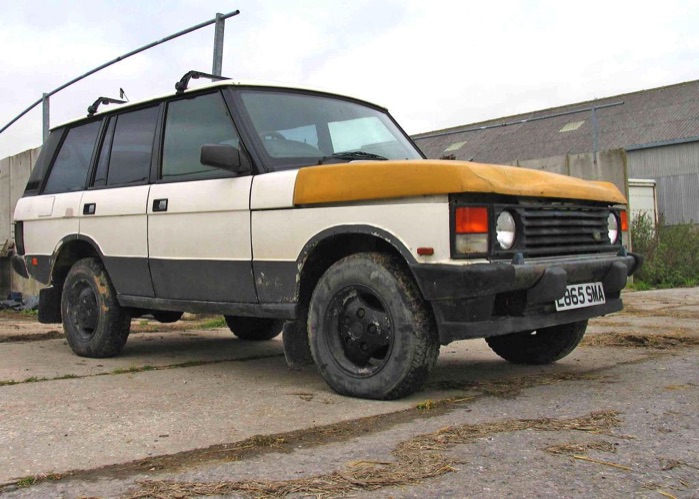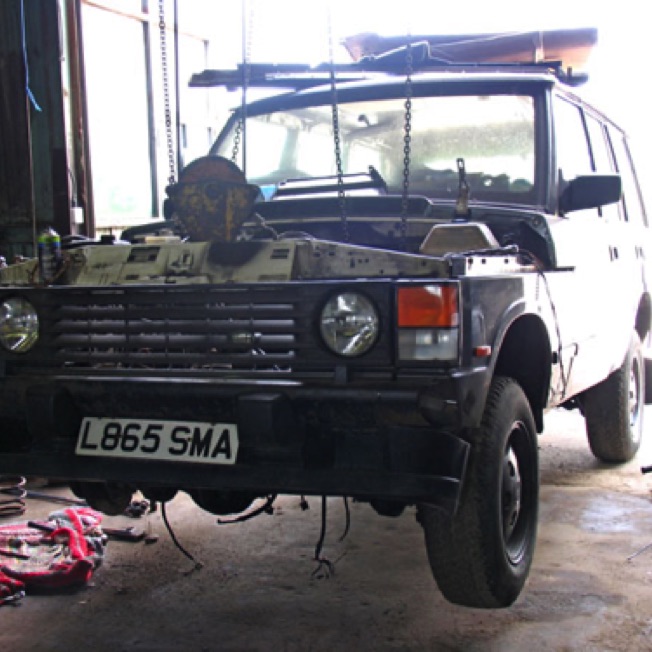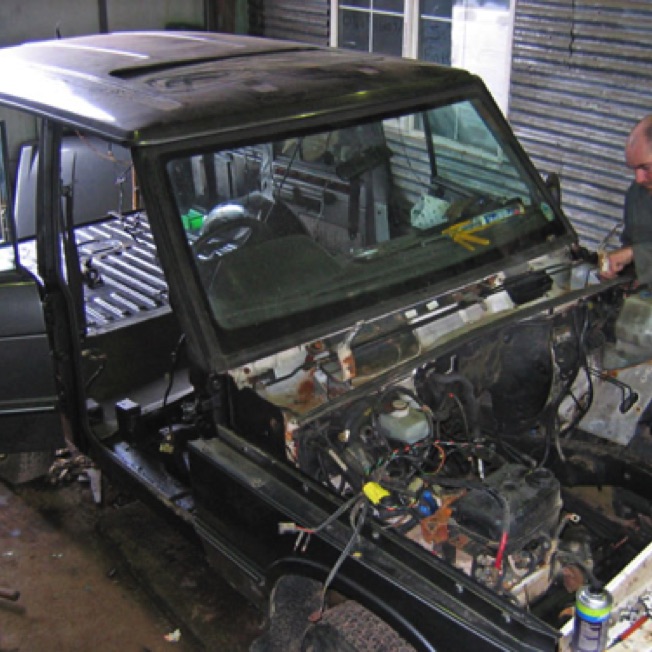
An inspired decision?
When Jeremy Walton’s partner wanted another Range Rover, and nothing but Generation One would do, a 22-month recycling saga began…
My partner, Deborah, would have rust-repaired her automotive workhorse, but sadly, some serious transmission work was also impending. The TDi bucked and jerked in parking manoeuvres like an unbroken equine.
Bertha had nobly served throughout rugged multiple tasks that Range Rover designers had in mind nearly 40 years ago when they specified rubber mats and 2-door bodies, but her Time was Up…
We got a £500 offer for the remains of Bertha, the hearty 200 TDi motor, which had covered some 127,000 of those total miles, the main attraction. And we started looking… and looking for a replacement.
Deborah definitely wanted another first generation Range Rover, preferably as similar as possible to the deceased with TDi diesel power and a decent body. I expect most readers could have told us we were wasting our time as we were not seeking a £10,000 plus collector’s gem but an everyday example below £5,000.
We scoured the secondhand specialist lots, bid on eBay and went up a blind alley with the successor P38, which seemed to have more electronic glitches than Prince of Darkness, Joe Lucas.
We already had an emergency Peugeot diesel estate to cover the absent Range Rover, so the search went on, diverted to the point of test driving Nissan’s smaller X-trail as Deborah had previous good durability experience with a clumsy but impressively tough Patrol.
September 2006, and we’d exhausted all the affordable buying alternatives. Now we could both spot under-body rust at 1000 yards and never wanted to hear another dealer’s soothing, “a bit of welding and she’ll do years for you.” I remembered building competition cars from a stripped body and thought we would at least know what was going on under those (mostly) rust- free external RR panels with their high percentage of aluminium sheet.
We would not afford the kind of total rebuilds that I am familiar with from the pristine professional classic and competition car world where you think of a sum from £25,000 upward.
So, we looked around for somebody with a practical hands-on approach and a bit of offroad motorsport experience. FBB, a Land/Range Rover specialist in a neighbouring West Country village seemed the answer, so we went along and talked to proprietor Rob White. We told Rob we did not want to spend more than £4,500 on a reborn 2.5 TDi, one stripped to bare metal, re-sprayed and rust-proofed with reconditioned or recycled healthy powertrain. All with the aim of getting at least five years relatively trouble-free service from it.
Robb liked the sound of a challenge and project Martha begun in October 2006 when we paid a £1500 deposit and acquired an ex-Cheshire Police vehicle, L865 SMA. Incidentally, the Cheshire force are credited with being the first customers for Range Rover in this role, taking their first deliveries in 1971.
Spookily, one of the FBB sub-contractors separately bought a sister Range Rover, L866 SMA shortly afterwards, but that was not to become one of 12 donors that yielded the hardware harvest to resuscitate Martha.
The legendary Roger Crathorne at Land Rover had a look at the chassis number I supplied and, with some internal factory help, deduced it was built as a 1995 Model Year 2.5 TDI in solid Alpine White with granite cloth trim. In RR slang it is a soft dash model, with the 4-spoke steering wheel. For the public that would have meant airbags, but there is no trace of these today, so I presume the police do without?
Perhaps most importantly it had, and retains, a now reconditioned version of a 300 TDi turbo diesel motor. Most of the other hardware would be replaced, including differential (but not the drive shafts); the R380 version of Rover’s 5-speed manual gearbox (which had only just replaced the LT77S a month before this project Range Rover was produced) was sourced from an M-plate Discovery that had suffered head gasket failure.
Mated to a 300 TDi motor, this 5-speeder was a an unexpected bonus, coming complete with invoices that revealed it was less than 10,000 miles since it had been reconditioned.
An all new clutch—but not its hydraulic operating system—was ordered, along with stiffer springs, standard Armstrong shock absorbers and disc brakes with fresh Mintex pads. Most new bits were supplied via Britpart and arrived without drama. Adapting a Disco sourced gearbox to a Range Rover linkage was a hiccup, and an unplanned differential swap became a last minute deal.
First delivered on April 15 1994 on the shorter 100-inch wheelbase, there were scant factory notes of police post-production additions for L865 SMA. Most notes covered mainly electrical items to cope with police auxiliary lighting demands, but there is no evidence of twin batteries on this example.
The men in Blue’s suspension requirements roused my interest. These amounted to a 10 per cent uprate in damper and spring rates, presumably to counteract extra weight, much of it high above the centre of gravity. Plus a limited role requiring high cornering loads in pursuit of badness. I determined to duplicate similar increase roll stiffness, as our earlier K-plate example did like to rock and roll.
The experienced amongst you will know that a 1994-ex Police Range Rover is likely to have gone to auction disposal with starship mileage accrued when it’s time was done. Bluntly, I can only guess that, because it is not terribly relevant to the vehicle we employed as the foundation for this conversion with a scant 117,000 displayed. When we got hold of it, recent life had been a hard offroad slog, tugging canoes and serving as transport for other assorted offroad pursuits on Red diesel. I think the pictures tell you most about it’s condition in Autumn 2006, but back then we were preoccupied with getting it stripped down to ensure that Robb’s favourable impressions of the low rust content in the main structure were correct.
The strip down was the fastest part of the process. L865 SMA was moved to a site outside the military Larkhill base, one of three premises then used by FBB. Over a week in early November 2006, it was pulled apart to a bare hull by up to three staff, including two apprentices.
Range Rover aficionados will know that those (mostly) alloy skinned panels detach particularly rapidly, especially the doors. I did not know that over 20 self-tapping screws secured the roof, but that detachable element proved very handy when installing an alternative roof complete with electric sunroof.
However, finding a headlining that had not sagged/become filthy beyond use was so tough we never really did get a satisfactory lining installed that matched the sunroof.
Other owner choices that were particularly relevant to rebuild speed/sourcing parts included a preference for cloth upholstery over leather. Cloth is much harder to source for tear-free front seats and it also tends to display stains more prominently, but the lady wanted cloth for its hot weather comforts. She had already specified that air conditioning was not wanted with the sunroof panel already acquired.
I made my third visit to the work in progress in late November 2006 and progress was still better than I had cynically expected. Without panels, the body and powertrain hung by chains from an enormous overhead gantry with support jacks to steady it. The motor had its ancillaries removed, but was still in place, along with the original gearbox and 4x4 transmission.
Rust inspection had proved the worth of Rob’s judgement. Nobody could have said the donor vehicle looked promising — especially as our old Range Rover had shone so deceptively before failing its MoT — but the main repair areas were confined to front scuttle; a cigarette packet-sized rear floor hole and smaller rust infestations on the floor wells of the passenger and driver areas.
Best to see the pictures to save us the traditional 1000 words here, but worth understanding, for those of us who do not already know, that the pink stuff you see in some shots converts rust to an oxide and is branded Coma.
The under body was sprayed in the traditional Waxoyl, but that messy but effective process came very late in the rebirth, so do not expect to hear anymore about that until our last episode.
Here’s how the Range Rover looked at the start of this project, with the story published as a 4-section partwork in Land Rover Enthusiast from the December 2008 issue onward.
CLASSIC RANGE ROVER RECYCLED –Part 1
CLASSIC RANGE ROVER RECYCLED –Part 1
May 2006 and our 1993 Range Rover TDi terminally failed its MoT. “Just not worth repairing’ was the verdict on the rust-riddled rear beams beneath deceptively shiny outer panels on the Vogue SE nicknamed ‘Bertha.’ The blue 5-door had absorbed over 230,000 demanding miles and two engines (the original VM unit was replaced with a 200 TDi motor), including a previous life hauling veterinary chemicals to Holland and my partner’s exploration of courses suitable for horse adventures.


